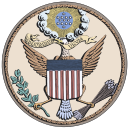Kansas in the American Civil War: Difference between revisions
| Line 15: | Line 15: | ||
[[Image:Battle of Lawrence.png|thumb|444px|center|''Quantrill's Raid'' into Lawrence, Kansas destroyed much of the city]] |
[[Image:Battle of Lawrence.png|thumb|444px|center|''Quantrill's Raid'' into Lawrence, Kansas destroyed much of the city]] |
||
Many were killed. Women men and children. Then kansas joined as a free state to go against missouri. IN the Civil War the war was kansas vs missuri |
|||
==External links== |
==External links== |
||
Revision as of 20:33, 18 April 2013
 |
|
Union states in the American Civil War |
|---|
|
|
| Dual governments |
| Territories and D.C. |
Even before the outbreak of the American Civil War, the territory of Kansas had been the scene of fighting between anti-slavery and pro-slavery forces. Kansas was admitted to the Union as a free state on January 29, 1861, three months before the opening battle of the war at Fort Sumter, and at the commencement of the war, the state's government had no well-organized militia, no arms, accoutrements or supplies, nothing with which to meet the demands, except the united will of officials and citizens. During the years 1859 to 1860, the military organizations had fallen into disuse or been entirely broken up.
Military activities
The first Kansas regiment was called on June 3, 1861, and the seventeenth, the last raised during the Civil War, July 28, 1864. The entire quota assigned to the Kansas was 16,654, and the number raised was 20,097, leaving a surplus of 3,443 to the credit of Kansas. Statistics indicated that losses of Kansas regiments killed in battle and from disease are greater per thousand than those of any other State.
The Battle of Baxter Springs, sometimes called the Baxter Springs Massacre, was a minor battle in the War, fought on October 6, 1863, near the modern-day town of Baxter Springs, Kansas.
On October 25, 1864, a series of three battles occurred, the first two in Linn County, Kansas, with the final in Vernon County, Missouri. The first was the Battle of Marais des Cygnes (also called the "Battle of Trading Post"), the second, a cavalry battle, was the Battle of Mine Creek, also known as the Battle of the Osage and the third was the Battle of Marmiton River (over the border in Missouri). They were between Major General Sterling Price, leading the Missouri expedition, against Union forces under Major General Alfred Pleasonton. Price, after going south from Kansas City, was initially met by Pleasonton at Marais des Cygnes. At the end of the day, the Confederates were forced to withdraw after attacks and assaults by Union forces.
Lawrence Massacre
After General Ewing ordered the imprisonment of women and children relatives of known Missouri guerrillas in a Missouri jail, the jail's roof tragically collapsed and killed a number of prisoners. These deaths enraged Missourians. On August 21, 1863, William Quantrill led Quantrill's Raid into Lawrence destroying much of the city and murdering over 150 unarmed men and boys. The Confederate partisans in Missouri rode to Lawrence (a town long hated by Quantrill and many Southerners) in response to the deaths of women and children. Quantrill also rationalized, an attack on this citadel of abolition would bring revenge for any wrongs, real or imagined that the Southerners had suffered. By the time the raid was over, Quantrill and his men had killed approximately 150-200 men, both young and old.

External links
- Online Exhibit - Keep the Flag to the Front, Kansas Historical Society
- Cool Things - Civil War Battle Flags, Kansas Historical Society
- The Civil War in Kansas: A Bibliography, Kansas Historical Society
